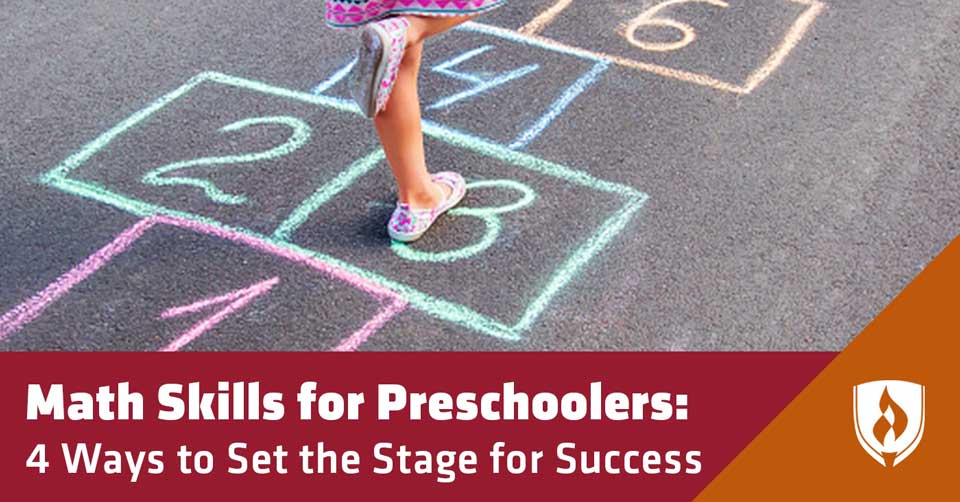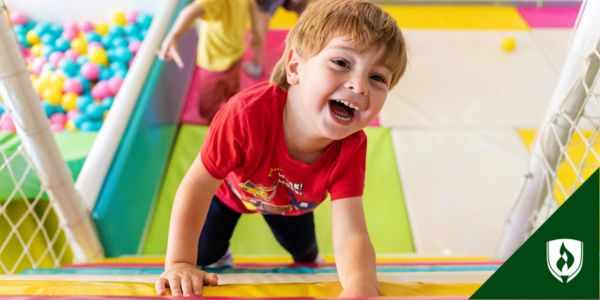
If math was never your top subject in school, it might seem hard to imagine yourself as one of the people responsible for teaching preschoolers the foundational mathematic skills they’ll need for future success. The good news is at this level you won’t be bogged down trying to remember the quadratic equation or what cosine means—you’ll be covering the basics for others to build upon. Better yet? You might be surprised just how receptive toddlers are to learning numbers, shapes, and even simple equations.
Teaching math to toddlers doesn’t have to be boring. In fact, it should be fun! And we’ll give you just the tools you need to do it. This article will break down some of the most important math skills for preschoolers and provide simple exercises to practice each one.
Why is it important to build math skills in preschool?
If you’re an early childhood educator, you probably already know the lasting impact early experiences have on the architecture of a child’s brain. Studies show that preschool not only influences cognitive abilities but also behavior, social skills and self-esteem.1
According to one study, the same neural networks that allow children to count to ten are those used to think about complex mathematics later on.2 By using math-related exercises now, you can help lay the foundation for problem-solving, logic, and even determination. So, as you explore math skills for preschoolers, you can be sure that your work is making a difference.
4 Math skills to develop in preschoolers
While being able to count to ten is important, math is about more than just numbers. As you help your toddlers develop the following skills, you’ll see that it’s a helpful lens to make sense of the world.
1. Number recognition
Being able to recognize numbers is the first step in carrying out more complex math skills. By using tactile materials, you can help children learn about numbers and see their value in terms of the world around them.
Try it at home:
- Numbered hopscotch: This is a great option because it’s simple and can be modified for every child. Either help call out the numbered squares as children move through them or have them do it on their own. All you need is some chalk and a stretch of pavement. As an added bonus, this is an easy way to burn off extra energy.
- Dice games: Dice are an underrated tool for developing numerical literacy. At a basic level, the dots on each side can be counted to reinforce how a number can be visualized. As they get more comfortable, start with simple games that involve taking turns rolling the dice. Once it lands on a number, call out a move like jumping jacks or spins and count out each motion until they reach the number on the dice. This helps children see that numbers can be represented in different ways.
2. One-to-one correspondence
This skill is all about recognizing when two different groups have the same number of items. As children learn to visualize numbers, it’s important to identify how they relate to things around them. One-to-one correspondence is a great way to make math "real" for them by using objects and scenarios from your everyday life.
Try it at home:
- Setting the table: This activity, from Zero To Three, helps children take responsibility for their own learning. By asking the child to lay out a plate for each member of your family, you can help them see the connection between plates and people. Emphasize “one for you,” “one for me,” and so on. Then, ask them how many plates there are total.
- Help in the kitchen: When you think about preschoolers in the kitchen, you may very well visualize the mess of all messes, but, according to PBS, baking can be a great way to help kids connect numbers to their lives. Have them top your cookies with chocolates. One candy for each cookie, then count the total number of cookies.
3. Comparing differences
Being able to distinguish differences in value, height, weight, and shape promotes critical thinking, spatial awareness and equips preschoolers for more advanced math skills.
Try it at home:
- Shape sorter: Let children simply explore the differences between shapes and colors by playing with a shape sorter. Buy one or make your own by cutting shapes into an empty cardboard box and use different objects from around the house.
- Compare yourself: Have children trace their hand on a piece of paper. Then, trace yours on top of it. Let them see the differences. Ask, “Which is bigger? Why?” You can also compare the size of your shoes, how far you can reach, and even the length of your shadows.
4. Identifying patterns
Learning about patterns helps children make predictions, logical connections, and use reasoning to solve problems. This requires them to recognize differences between items as well as how they function together.
Try it at home:
- Patterns with blocks: Start a pattern with different color blocks such as blue, red, blue and so on. Prompt the child to continue the pattern. This activity from YoungMathematicians not only helps children spot intentional designs but helps develop motor skills and mirroring.
- When in doubt, sing: One of the easiest ways for children to recognize patterns is in song and rhyme. While they don’t necessarily have to be about math-related topics, there are plenty of songs that help children learn to count, sort, compare and more. Playing songs like this in the car or at home is just another way to make learning about math fun.
Empower preschoolers to think big
From the outside, these activities may just look like fun ways to pass the time with toddlers, but there is far more going on beneath the surface. By investing in math skills for preschoolers, you’re helping develop crucial early experiences that help children make sense of the world. This is one of the many reasons early childhood educators continually explore new ways to empower their students.
If you’re interested in taking your ECE practice to the next level, check out our article, “What Can I Do with an Early Childhood Education Degree?”, to see how education could help you increase your impact.
Related Articles:
1National Bureau of Economic Research, Schools, Skills and Synapses [accessed August 2020] https://www.nber.org/papers/w14064
2Proceedings of The National Academy of Science of The United States of America, Origins of The Brain Networks For Advanced Mathematics In Expert Mathematicians [accessed August 2020] https://www.pnas.org/content/113/18/4909




